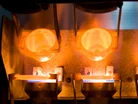As World Shuns Coal, Steelmaking Coke Demand Holds Steady

The demise of steam coal -- also known as thermal coal -- has been well documented, as investors shy away from the fossil fuel that fired the Industrial Revolution and has been an energy mainstay pretty much ever since, save for the past decade or so.
But, as Reuters writes, one corner of the coal market is thriving: metallurgical coal, otherwise known as coking coal, and vital for making steel.
For their part, steel producers are reliant on metallurgical coal, as it is an essential fuel for the blast furnaces used in steelmaking, providing both the necessary heat and carbon needed to turn iron ore into steel, and is used to produce about 70% of the world’s 1.8 billion tons of steel each year.
This is why the demand for metallurgical coal is coupled to the demand for steel, and why most primary steelmakers have a division that produces coal for coking, to ensure a stable and low-cost supply.
High price of green steel stokes demand for coke
For steel to be greener, producers need to move away from coke-fuelled furnaces and instead use electric-arc furnaces (EAF) fed with steel scrap and reduced iron, and powered by renewable energy, such as hydrogen or electricity.
But the reality is that steelmaking is unlikely to make further significant reductions in its reliance on coke without both a change in regulations and also price incentives, to drive a shift in steel investment and consumption.
The price premium on green steel is around $150 a metric ton, and Reuters reports that even a relatively modest premium on green steel makes it unattractive to much of the market, with automotive manufacturing being the only sector prepared to pay a premium for green steel, because it is able to absorb the extra cost into the retail price of a vehicle – and also gain significant consumer kudos for making an environmentally friendly product.
However, Reuters points out that the biggest steel consumers are property and infrastructure, which used a combined 518 million tons in 2024, or 57% of the total. It also points out that high-speed rail uses between 30,000 and 60,000 tons of steel per kilometre. Higher-price green steel remains unattractive to these sectors.
This is why, it says, that sustainability regulations around steel production are needed to take decarbonisation efforts to the next level, coupled with fiscal measures such as carbon border taxes.
So for now, the coke market remains buoyant – which is great news for Anglo American, who seem set to sell its coke interests as part of the business restructuring designed to thwart rival BHP’s $49bn takeover attempt.
- Steel Recycling 'can Counter Coal & Iron Mining Carbon Cost'Sustainability
- GEM: China Coal Mine Expansion Poses Methane RiskSustainability
- Coal Power 'on Wane but China & India Account for 86%'Supply Chain & Operations
- UK Coal Mine Legal Battle puts Sustainability in SpotlightSustainability



